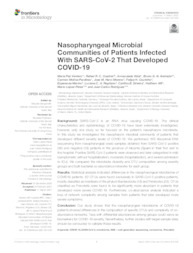Nasopharyngeal microbial communities of patients infected with SARS-CoV-2 that developed COVID-19.
Nasopharyngeal microbial communities of patients infected with SARS-CoV-2 that developed COVID-19.
Author(s): PAZ VENTERO, M.; CUADRAT, R. R. C.; VIDAL, I.; ANDRADE, B. G. N.; MOLINA-PARDINES, C.; HARI-MORENO, J. M.; COUTINHO, F. H.; MERINO, E.; REGITANO, L. C. de A.; SILVEIRA, C. B.; AFLI, H.; LÓPEZ-PÉREZ, M.; RODRÍGUEZ, J. C.
Summary: Background: SARS-CoV-2 is an RNA virus causing COVID-19. The clinical characteristics and epidemiology of COVID-19 have been extensively investigated, however, only one study so far focused on the patient?s nasopharynx microbiota. In this study we investigated the nasopharynx microbial community of patients that developed different severity levels of COVID-19. We performed 16S ribosomal DNA sequencing from nasopharyngeal swab samples obtained from SARS-CoV-2 positive (56) and negative (18) patients in the province of Alicante (Spain) in their first visit to the hospital. Positive SARS-CoV-2 patients were observed and later categorized in mild (symptomatic without hospitalization), moderate (hospitalization), and severe (admission to ICU). We compared the microbiota diversity and OTU composition among severity groups and built bacterial co-abundance networks for each group. Results: Statistical analysis indicated differences in the nasopharyngeal microbiome of COVID19 patients. 62 OTUs were found exclusively in SARS-CoV-2 positive patients, mostly classified as members of the phylum Bacteroidota (18) and Firmicutes (25). OTUs classified as Prevotella were found to be significantly more abundant in patients that developed more severe COVID-19. Furthermore, co-abundance analysis indicated a loss of network complexity among samples from patients that later developed more severe symptoms. Conclusion: Our study shows that the nasopharyngeal microbiome of COVID-19 patients showed differences in the composition of specific OTUs and complexity of co-abundance networks. Taxa with differential abundances among groups could serve as biomarkers for COVID-19 severity. Nevertheless, further studies with larger sample sizes should be conducted to validate these results.
Publication year: 2021
Types of publication: Journal article
Keywords: COVID 19, Coronavirus, Microbiome, NGS next generation sequencing, Prevotella, SARS CoV 2
Observation
Some of Embrapa's publications are published as ePub files. To read them, use or download one of the following free software options to your computer or mobile device. Android: Google Play Books; IOS: iBooks; Windows and Linux: Calibre.
Access other publications
Access the Agricultural Research Database (BDPA) to consult Embrapa's full library collection and records.
Visit Embrapa Bookstore to purchase books and other publications sold by Embrapa.

